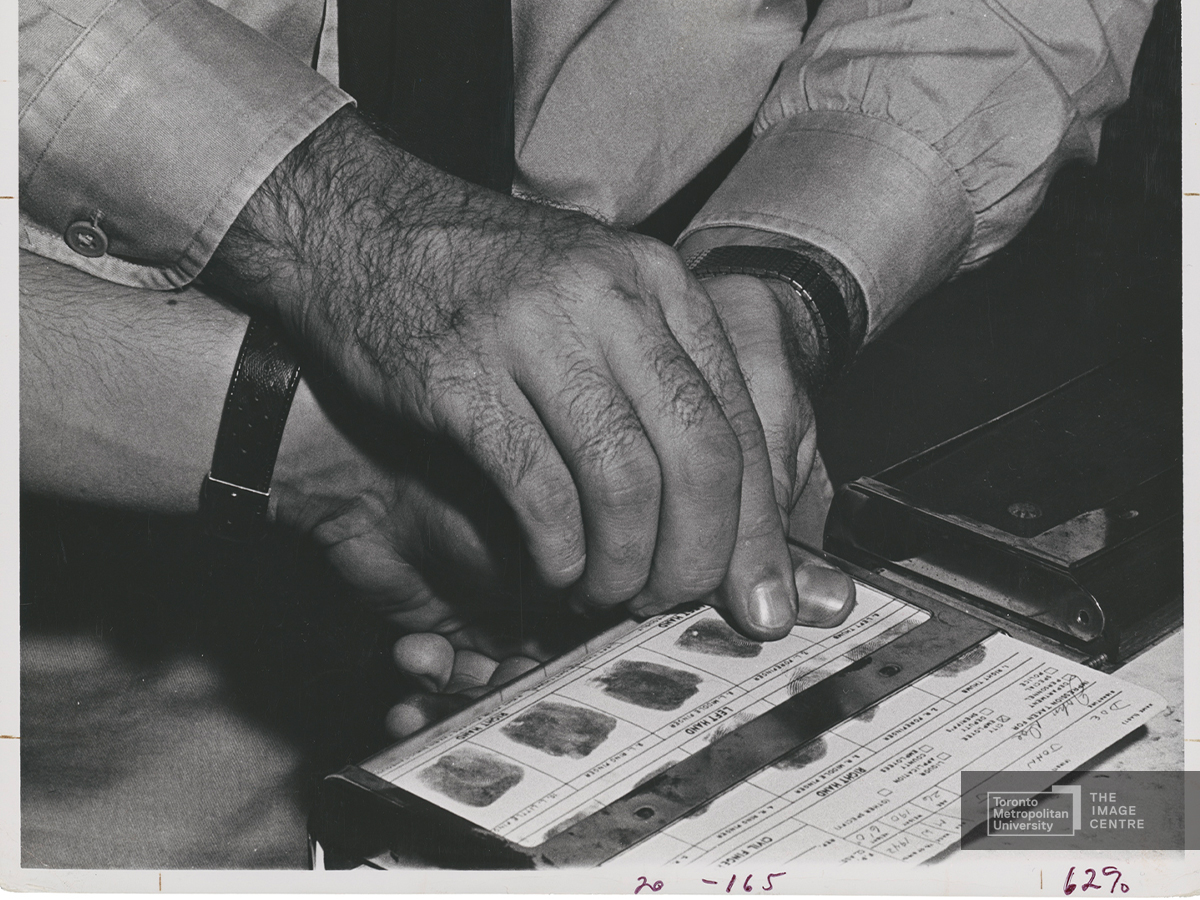Chicago Police Department
Labeling Theory
Labeling Theory: criminal justice practices (e.g. arrest) changes a person’s self-image along with the way other people see them and this increases the person’s involvement in crime and isolates them from society.
Title: Unknown.
Object Type: photograph
Dimensions: 8 x 10 inches; 20.32 x 25.4 cm
Medium: gelatin silver print
Date: unknown
Location: unknown
Accession No: BS.2005.268668
Photographer: Chicago Police Department
Category: The Black Star Collection, Toronto Metropolitan University. Courtesy of The Image Centre.
Inscriptions: Recto, handwritten: 20-165, 162%; Verso, handwritten: Training Academy, Top; stamped: [star] / Credit: / from BLACK STAR (x2); 3 [circled, crossed out] / 4 [circled] / ch. 19-C; stamped: Chicago Police Department / Official Photo / Please credit

Museum Label by Ruth Nortey and Émilie Vanhauwaert, CR8002 : Critical Engagement and Criminological Theories, Winter 2020
As criminal mobility grew in the 20th century, there was a greater need for law enforcement agencies to communicate and share information effectively between themselves. An offender was able to travel from one state to another without being apprehended by law enforcement agencies. After World War I, New York and Chicago had the largest fingerprint files in the U.S. and by the 1930s, the rest of the Western world began to use fingerprinting as the main method of identification.
The U.S. witnessed a period marked by many human rights movements in the 1960s and 1970s. The deaths of Martin Luther King Jr. and Robert Kennedy in 1968 created a lot of frustration and unrest. In response to this, Chicago saw a significant number of street riots and violent demonstrations that year. Violence erupted outside of Chicago’s National Convention that summer because citizens - a majority of whom were a part of student led activist organizations and ‘hippies’ from the Youth International Party - had begun to question the motives behind the Vietnam War. On this day, the entire country watched what unfolded on their television screens as officers removed their badges and beat and clubbed the demonstrators. A majority sided with the police force because the older generation grew fearful of what they had witnessed on their screens that day. Many argue that this aided Republican candidate Nixon win his election the next year as he represented an image of being ‘tough on crime’.
As a result, recording and keeping track of the identity of offenders, such as the hundreds that participated in these riots, became an important priority for the police. Fingerprinting was the most efficient system to capture one’s identity and is still the leading method for criminal identification today. The American ‘RAP sheet’ is the best known criminal record currently in use. According to the Chicago Police Department, this sheet must contain the offenders fingerprints as well as a lifetime record of charges and arrests. Within the United States, criminal justice contact is disproportionately concentrated amongst young black men. The outcome of getting fingerprinted in the criminal justice system gives an individual a ‘criminal identity’. Unfortunately, the stigma tied to this identity has been known to create barriers for offenders, such as getting a job, further preventing successful reintegration back into society.
Bibliography
- Boyer, P. S., Clark, C. E., Halttunen, K., Salisbury, N., Kett, J. F., Sitkoff, H., & Woloch, N. (2014). The enduring vision: A history of the American people. Volume II: Since 1865. Boston, MA: Nelson Education.
- Chicago Police Department. (2008). Guidelines for Fingerprinting. Retrieved from the Chicago Police Department (external link, opens in new window)
- Cole, S. A. (1998). Manufacturing identity: A history of criminal identification techniques from photography through fingerprinting (Doctoral dissertation, Cornell University).
- Cole, S. A. (2001). Suspect Identities: A History of Fingerprinting and Criminal Identification. Cambridge, MA: Harvard University Press.
- Cullen, F. T., Agnew, R., & Wilcox, P. (2018). “Part VI: Labeling Theory: Societal Reaction and the Creation of Criminals”, Criminological theory: Past to present: Essential readings (Sixth ed.) Oxford University Press.
- Finn, J. M. (2009). Capturing the criminal image: From mugshot to surveillance society Minneapolis, MN: University of Minnesota Press.
- Jacobs, J. B. (2015). The Eternal Criminal Record. Cambridge, MA: Harvard University Press.
- Morris, S., & Taylor, D. (2018, August 19). The whole world is watching: How the 1968 Chicago 'police riot' shocked America and divided the nation. Retrieved from https://www.theguardian.com/us-news/ng-interactive/2018/aug/19/the-whole-world-is-watching-chicago-police-riot-vietnam-war-regan.
- Pettit, B., & Gutierrez, C. (2018). Mass incarceration and racial inequality.American Journal of Economics and Sociology, 77(3-4), 1153-1182.